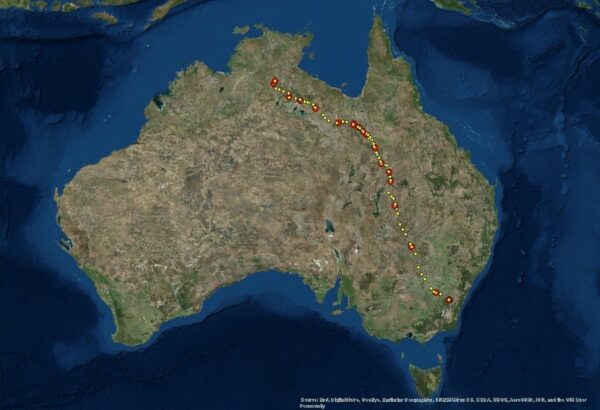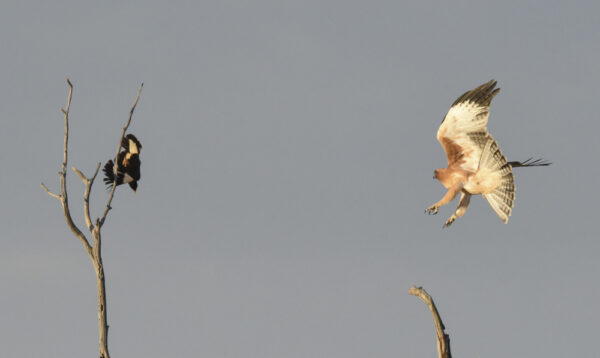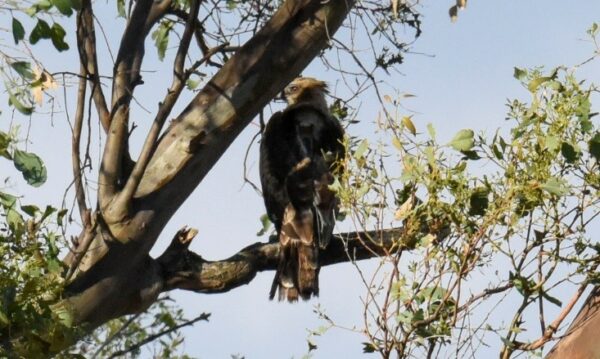Little Eagle’s big trek
One Little Eagle’s epic trek of 3300 kilometres from Canberra to the Northern Territory outback has intrigued the ACT collaborators who have been monitoring the adult male bird through satellite tracking.
“A joint research project being undertaken by the ACT Government, University of Canberra, CSIRO and Ginninderry Joint Venture, is providing a fascinating insight to the travel patterns of the little eagle,” according to ACT Environment and Heritage Minister, Mick Gentleman. “It is the first time this threatened species has been subject to satellite tracking,” Minister Gentleman said.
“After successfully raising a chick in West Belconnen during Spring/early Summer, the one we are tracking has taken off to spend time in the tropical heat near Daly Waters in the Northern Territory – a flight path of 3,300 kilometres.
“This distance was travelled in under three weeks and included flying 500 kilometres in one day, as well as reaching a maximum speed of 55 kilometres per hour,” Minister Gentleman said.

Study of Strathnairn eagle
The movements of this male Little Eagle from a pair using the nesting area at Strathnairn near West Belconnen have been monitored since the bird was first caught and satellite tagged in October 2015, as part of a study by researchers from the University of Canberra Institute for Applied Ecology, funded by Ginninderry (formerly Riverview Projects).
Experienced raptor experts fitted a lightweight, solar-powered, programmable Argos transmitter specifically designed for use on birds. The unit was programmed to record eight position fixes each day at 2-3 hour intervals from 5am to 8pm and a midnight fix to inform roosting locations. The tracking unit had the ability to show altitude (3D) as well as 2D positional information.
The bird’s northern sojourn was unexpected because, in the time since it was first satellite tracked, it had moved mainly in a localised zone extending from south of Strathnairn to the east of the Murrumbidgee, across to Wallaroo in the north and CSIRO Ginninderra in the east.
“The Belconnen little eagle pair successfully raised a chick this year. During the nesting season, the male is thought to have hunted mainly juvenile rabbits and middle sized birds such as magpies, rosellas and starlings over an area of 65 square kilometres, ranging from the junction of the Molonglo and Murrumbidgee rivers north-east to the CSIRO land along the Barton Highway and north to Wallaroo in NSW,” according to Minister Gentleman.
“On Thursday 9 March 2017 the male eagle suddenly left Canberra on its odyssey to the north. The little eagle was suspected of migrating between breeding and wintering territories. This study provides the first proof of this and a clear indication of the vast distances involved,” he said.
During the monitoring from late October 2015 through to the end of January 2016, (Source: University of Canberra, Brawata and Gruber 2016) 918 usable fixes were recorded – 27% of the time while the bird was flying and 73% of the time while it was roosting.
On average the bird travelled 9.87 kilometres per day with a maximum distance of close to 28 kilometres in a day.
‘This male Little Eagle showed a higher use of open woodland habitat followed by grassland but often flew over urban areas to access foraging grounds that were separated by 20km,’ according to the report. ‘The results indicate a preference for large trees for roosting and shelter as well as foraging habitat.’
The researchers concluded that information on movements and activity from this study should be combined with data on juvenile survival and dispersal and potentially tracking of another adult in the next breeding season to gain more accurate estimations of land use during breeding.
Follow-up research and tracking
Following a breeding event at CSIRO Ginninderra in 2015, CSIRO purchased two similar satellite tracking devices and has made these available for use at Ginninderra (in the event that a breeding pair returns to the CSIRO site) or elsewhere in the district.
The unexpected flight of the Strathnairn male to Northern Australia highlighted some of our knowledge gaps according to CSIRO ecologist, Jacqui Stol.
“The recent monitoring shows us just how much we still don’t know about the range, movements, behaviours and breeding territories of the Little Eagle.”
“These knowledge gaps and the common desire to maintain a viable breeding population in the ACT and nearby NSW are prime reasons that we are working together with the ACT Government Environment Directorate, raptor experts and the Ginninderry Joint Venture, to put together a plan of targeted Little Eagle research,” says Jacqui.
Minister Gentleman said the research project will further study the ecology of the little eagle in the coming year through plans to place cameras at nest locations and attaching trackers to additional birds. The knowledge gained will guide future management and development decisions.

Juvenile responds to a mobbing by Common Myna birds near Strathnairn on 27 January 2017. Photo: Stuart Rae.

This adult male pictured near Strathnairn on 27 January 2017 flew to the Nothern Territory about five weeks later. Photo: Stuart Rae.

